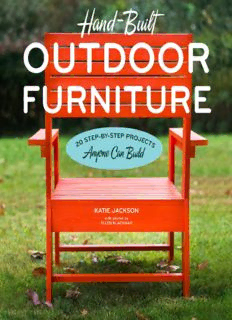
Hand-built outdoor furniture : 20 step-by-step projects anyone can build PDF
Preview Hand-built outdoor furniture : 20 step-by-step projects anyone can build
Hand-Built OUTDOOR FURNITURE 20 STEP-BY-STEP PROJECTS Anyone Can Build KATIE JACKSON with photos by ELLEN BLACKMAR TIMBER PRESS PORTLAND, OREGON To everyone who’s ever said, “I could never do that!” Contents PREFACE Be Confident! Part One BUILDING YOUR OWN GARDEN FURNITURE SHOP CONFIDENTLY FOR LUMBER BOARD BASICS Choosing Boards Softwoods Types of Softwood Lumber Measurements Woodworking Materials TOOLS OF THE TRADE Measuring Tools Saws Drilling Tools Other Indispensable Tools BUILD YOUR SKILLS Safety First How to Use a Miter Saw How to Use a Band Saw How to Use a Coping Saw How to Use a Jigsaw How to Use a Circular Saw How to Make a Jig How to Use a Clamp How to Use a Drill Press How to Use a Sanding Block How to Use a Palm Sander JOINING BOARDS Measuring and Marking Locations for Screw Holes Making Perfect Seams Making Plugs How to Counterbore and Plug Holes FINISHING TOUCHES: STAINING AND PAINTING Part Two PROJECTS SHAKER PEGBOARD SHELF TRELLIS STAIR BOX PLANTERS FLOWER BOX NAUTICAL END TABLE GARDEN SWING PLANT SHELF TWO-BOARD BENCH GOTHIC ARCH CHICKADEE HOUSE POTTING BENCH ROLLING COFFEE TABLE SLAT BENCH TORCHIERE SECTIONAL FURNITURE WITH STORAGE: CHAIR SECTIONAL FURNITURE WITH STORAGE: OTTOMAN SECTIONAL FURNITURE WITH STORAGE: LOUNGER BISTRO TABLE INTERNATIONAL ORANGE CHAIR CHAISE LONGUE OBELISK ACKNOWLEDGMENTS METRIC CONVERSIONS FURTHER READING PHOTOGRAPHY CREDITS INDEX PREFACE Be confident! With a few basic tools and a weekend, you can build a beautiful piece of furniture out of wood for your outdoor space. In my experience, woodworking is mostly about problem solving. How can I make this more structurally stable? How should I correct this mistake? Everyone solves problems differently, and over the course of my woodworking career building furniture alongside other builders and teaching young woodworkers, I’ve enjoyed seeing a multitude of ways to cut a board or calculate a measurement. In my woodworking classes, I provide an example of a project I’ve built, such as the flower box a student favorite—and ask the students to figure out their own process to build it. The projects I provide have no specific measurements and no written instructions, but once they study the pieces, the students can easily see how they are constructed and re-create the projects with their own desired measurements and personal flourishes. My students often use interesting and innovative ways to get to the same end point. I learn a lot from them, and I often notice a trend: once given a basic understanding of how to use woodworking tools and machines, many of the younger students are thrilled to be given the chance to solve problems through their own creativity, while many of the older students, especially adults, request help every step of the way and keep asking what to do next. Nonetheless, the intrepid younger students and the cautious older students, when given the same instruction on tool use and the same amount of time, all seem to produce the same caliber of high-quality woodworking. Perhaps this is because as we get older, we become more critical of ourselves. We may expect ourselves to be skilled in subjects we’ve never studied. We may be worried someone will see our work and criticize it, or that our work is not as good as someone else’s. That kind of worry can prevent us from ever starting or continuing to learn a new skill. I encourage you to just begin. Getting away from glowing screens and doing something with your hands is a satisfying use of spare time. Even if your project ends up looking different from what you expected, you’ll have exercised your brain and body to create something all your own. We are all our own worst critic, but remember, your friends and family won’t see the dent in the board from dropping it on the floor; they’ll see a beautiful new piece of furniture that you made with your own hands. Take pride in your work, continue to be willing to learn new skills, and share your newfound skills with others. You’re continuing an ancient human tradition. Part One BUILDING YOUR OWN GARDEN FURNITURE
Description: